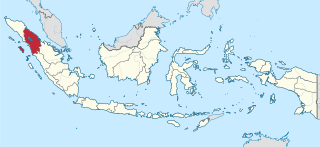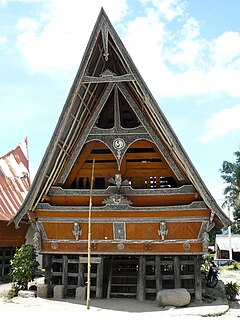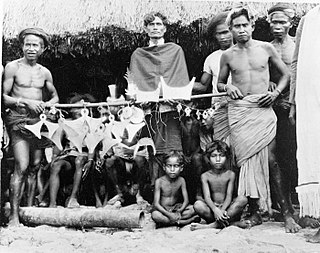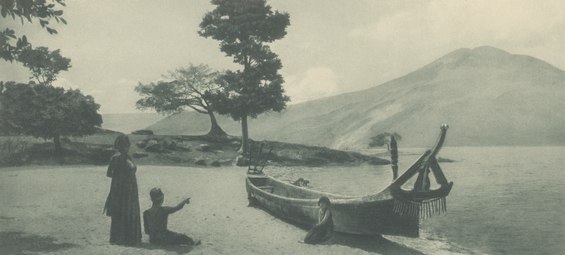
Lake Toba is a large natural lake in North Sumatra, Indonesia, occupying the caldera of a supervolcano. The lake is located in the middle of the northern part of the island of Sumatra, with a surface elevation of about 900 metres (2,953 ft), the lake stretches from 2.88°N 98.52°E to 2.35°N 99.1°E. The lake is about 100 kilometres long, 30 kilometres (19 mi) wide, and up to 505 metres (1,657 ft) deep. It is the largest lake in Indonesia and the largest volcanic lake in the world. Toba Caldera is one of twenty Geoparks in Indonesia, and was recognised in July 2020 as one of the UNESCO Global Geoparks.

Medan is the capital and largest city of the Indonesian province of North Sumatra. A regional hub and financial centre of Sumatra, it is one of the four main central cities of Indonesia, alongside Jakarta, Surabaya, and Makassar. As of the 2020 Census, Medan has a population of 2,435,252 within its city limits, and over 3.4 million in its built-up urban area, making it the fourth largest urban area in Indonesia. The Medan metropolitan area—which includes neighbouring Binjai, Deli Serdang Regency, and a part of Karo Regency—is the largest metropolitan area outside of Java, with 4,744,323 residents counted in the 2020 Census. Medan is a multicultural metropolis and a busy trading city bordered by the Strait of Malacca. A gateway to the western part of Indonesia, Medan is supported by the Port of Belawan and Kualanamu International Airport, both of which are connected to the city centre via toll roads and railways.

North Sumatra is a province of Indonesia located on the northern part of the island of Sumatra. Its capital and largest city is Medan. North Sumatra is Indonesia's fourth most populous province after West Java, East Java and Central Java. It covers an area of 72,981 km2. According to the 2020 census, the province's population in that year was 14,799,361.

Batak is a collective term used to identify a number of closely related Austronesian ethnic groups predominantly found in North Sumatra, Indonesia who speak Batak languages. The term is used to include the Karo, Pakpak, Simalungun, Toba, Angkola, and Mandailing which are related groups with distinct languages and traditional customs (adat).

Pencak silat is an umbrella term for a class of related Indonesian martial arts. In neighbouring countries, the term usually refers to professional competitive silat. It is a full-body fighting form incorporating strikes, grappling and throwing in addition to weaponry. Every part of the body is used and subject to attack. Pencak silat was practiced not only for physical defense but also for psychological ends.

Rumah Gadang or Rumah Bagonjong "house for the Minangkabau people" are the traditional homes of the Minangkabau in West Sumatra, Indonesia. The architecture, construction, internal and external decoration, and the functions of the house reflect the culture and values of the Minangkabau. A Rumah Gadang serves as a residence, a hall for family meetings, and for ceremonial activities. In the matrilineal Minangkabau society, the Rumah Gadang is owned by the women of the family who live there; ownership is passed from mother to daughter.

The Karo, or Karonese, are a people of the 'tanah Karo' of North Sumatra and a small part of neighboring Aceh. The Karo lands consist of Karo Regency, plus neighboring areas in East Aceh Regency, Langkat Regency, Dairi Regency, Simalungun Regency and Deli Serdang Regency. In addition, the cities of Binjai and Medan, both bordered by Deli Serdang Regency, contain significant Karo populations, particularly in the Padang Bulan area of Medan. The town of Sibolangit, Deli Serdang Regency in the foothills on the road from Medan to Berastagi is also a significant Karo town.

Elio Modigliani was an Italian anthropologist, zoologist, explorer, and plant collector.

Anton Willem Nieuwenhuis was a Dutch explorer and physician who travelled extensively in central Borneo in the 1890s, recording valuable ethnographic information about the Dayak people and making biological collections.

Toba people also referred to as Batak Toba people are the largest group of the Batak people of North Sumatra, Indonesia. The common phrase of ‘Batak’ usually refers to the Batak Toba people. This mistake caused by the Toba people being the largest sub-group of the Batak ethnic and their differing social habit to self-identify as merely Batak instead of ‘Toba’ or ‘Batak Toba’, contrary to the habit of the Karo, Mandailing, Simalungun, Pakpak communities who commonly self-identified with their respective sub-groups.

Batak architecture refers to the related architectural traditions and designs of the various Batak peoples of North Sumatra, Indonesia. There are six groups of Batak who speak separate but related languages: the Angkola, the Mandailing to the south, the Toba, to the north the Pakpak/Dairi, the Simalungun, and the Karo. While the groups are now Muslim or Christian, elements of the ancient Batak religion remain, particularly amongst the Karo.

Rumah adat are traditional houses built in any of the vernacular architecture styles of Indonesia, collectively belonging to the Austronesian architecture. The traditional houses and settlements of the several hundreds ethnic groups of Indonesia are extremely varied and all have their own specific history. It is the Indonesian variants of the whole Austronesian architecture found all over places where Austronesian people inhabited from the Pacific to Madagascar each having their own history, culture and style.

The national costume of Indonesia is the national costume that represents the Republic of Indonesia. It is derived from Indonesian culture and Indonesian traditional textile traditions. Today the most widely recognized Indonesian national costumes include batik and kebaya, although originally those costumes mainly belong within the island of Java and Bali, most prominently within Javanese, Sundanese and Balinese culture. Since Java has been the political and population center of Indonesia, folk costume from the island has become elevated into national status.

Karakoa were large outrigger warships from the Philippines. They were used by native Filipinos, notably the Kapampangans and the Visayans, during seasonal sea raids. Karakoa were distinct from other traditional Philippine sailing vessels in that they were equipped with platforms for transporting warriors and for fighting at sea. During peacetime, they were also used as trading ships. Large karakoa, which could carry hundreds of rowers and warriors, were known as joangas by the Spanish.

Pustaha is the magic book of the Toba Batak people of North Sumatra, Indonesia. The book contains magical formulas, divinations, recipes, and laws. The pustaha is written and compiled by a Batak magician-priest (datu).

Madaka, also written as mendaka, is a type of precious metal valuable to the Sumba people of Sumba Island, Indonesia. It is found in the megalithic culture of the western Sumba people, e.g. the tribe of Anakalang. Of all precious metal valuable to Sumba people, the madaka is considered to be the most sacred type of gold heirloom.

Rumah ulu is a vernacular house found in the highland of South Sumatra, Indonesia. The house is associated with the Uluan people who reside in the region of the upstream of the Ogan and Musi River.

The tube zither is a stringed musical instrument in which a tube functions both as an instrument's neck and its soundbox. As the neck, it holds strings taut and allows them to vibrate. As a soundbox or it modifies the sound and transfers it to the open air. The instruments are among the oldest of chordophones, being "a very early stage" in the development of chordophones, and predate some of the oldest chordophones, such as the Chinese Se, zithers built on a tube split in half. Most tube zithers are made of bamboo, played today in Madagascar, India, Southeast Asia and Taiwan. Tube zithers made from other materials have been found in Europe and the United States, made from materials such as cornstalks and cactus.

Knabat bogolu is a type of traditional war vessel from Mentawai islands, west Sumatra, Indonesia.

Tapanoeli Residency was an administrative subdivision of the Dutch East Indies with its capital in Sibolga. It was located in northern Sumatra and existed in various forms from 1844 until the end of Dutch rule in 1942. The area it encompassed at various times corresponds to most of the western coast of the current day Indonesian province of North Sumatra and parts of Aceh, including much of the traditional heartland of Batak people (called in their language Tano Batak. Lake Toba, a historically important crater lake, was also within the borders of the Residency.





























